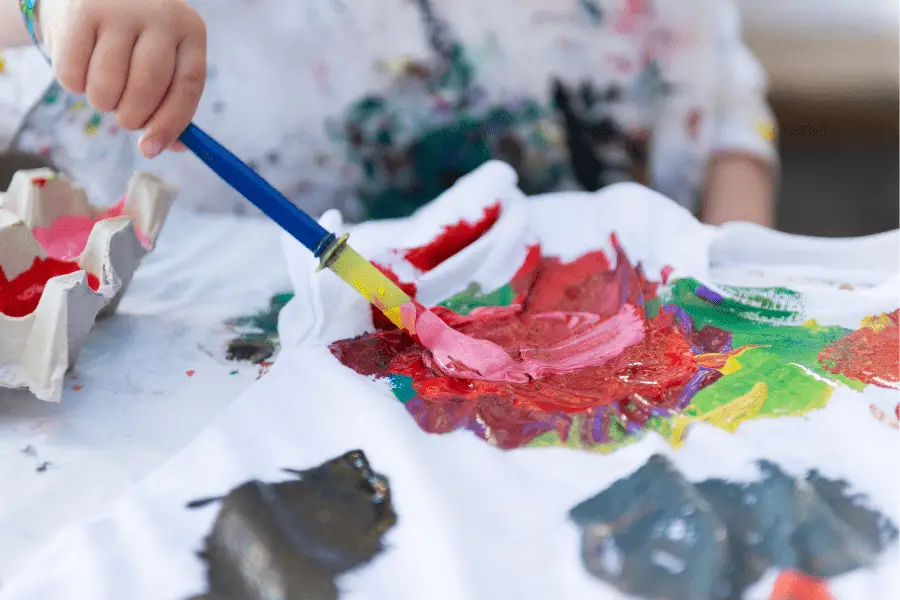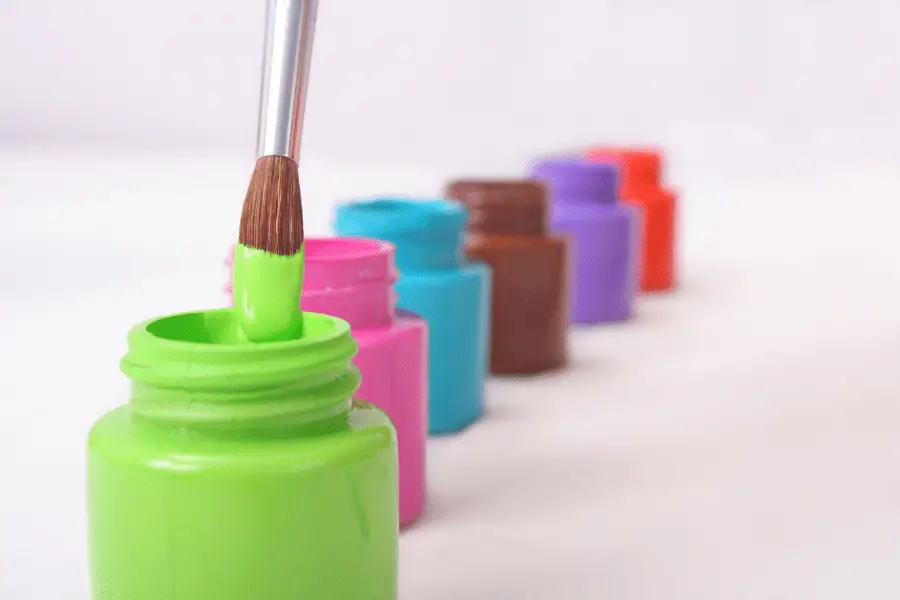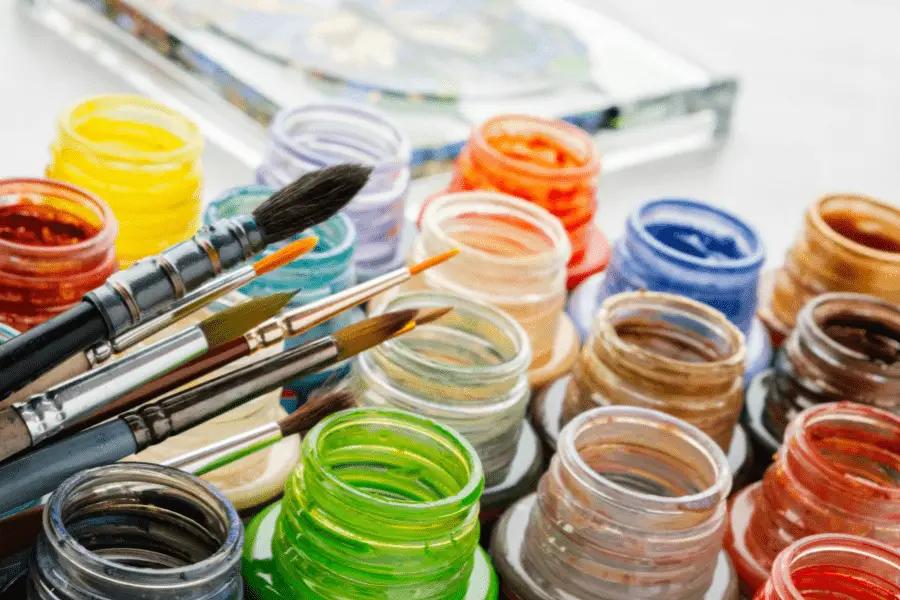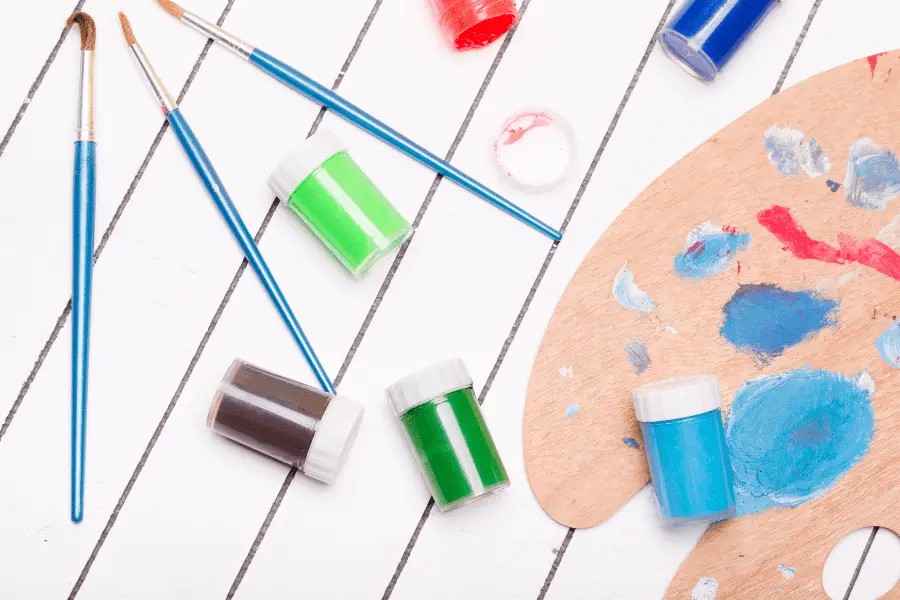Tempera paint is a lot of fun to work with, because it’s non-toxic and perfect for kids. Most kiddos get some type of paint on their clothes by accident, so you may be wondering if the tempera paint will wash off. If you’re purposely painting on fabric with tempera paint, or you accidentally spilled some you’re in luck!
So, does tempera paint wash off clothes? Yes! You can wash tempera paint off clothes before they dry. Start by rinsing the spot with cold water. Next, apply some detergent to the stain directly, wring out the clothes, then load them into your washer. By acting fast, the paint won’t stain.
Overall, you can remove tempera paint from clothes if you rinse them off quickly enough. The water helps prevent the color from drying, so you can wash it before it sets. Let’s keep reading to learn more!
How To Wash Tempera Paint off Clothes

Tempera paint consists of water-based ingredients, making it easier to get out of your clothes when compared to other types of paints. You can easily remove tempera with soap and water without worrying about staining!
There are a few steps to ensure the paint doesn’t stick to your clothes. These include:
- Remove excess paint and run the clothing item under cool water. Make sure the water thoroughly soaks into the area with the paint stains.
- Next, pour a detergent that’s safe for the garment directly on the stain. Work it in gently.
- If the paint is very dark, you may want to rinse the stain, then reapply detergent.
- Wring out the clothing, so it’s not dripping.
- Load the garment in the washer with similar pieces.
- Wash your clothes like usual.
My favorite and top pick is always Arteza Tempera Paints. They have so many different colors, and the quality is amazing! I usually use Arteza Paints for all my projects.

The paint should come out during the wash cycle! Since tempera paint has water-based products in it, the color should come out fully. Often, the stain comes out during the rinse rinsing step, but it’s best to wash the item anyway.
That way, you know for sure your favorite clothing items won’t be left with a stain!
Is Tempera Paint Permanent on Fabric?
Tempera paint can stick to a variety of surfaces. Many artists use it on fabric, canvas, paper, and more. However, this does mean it can be permanent on fabric, so you’ll want to be careful when working with it. I always recommend wearing a smock or apron while painting!
Luckily, tempera paint isn’t as permanent as oil paint or even acrylics. If you let your garment sit for too long, it will be a lot harder to remove the paint. Although, quickly rising off the fabric ensures there won’t be a stain.
Tempera paints are similar to watercolors in that they’re only semi-permanent. That means you can wet the paint and make it spreadable again- which has plenty of uses. Plus, this characteristic also means it won’t last if you put it in the wash.
If you want the tempera paint to be permanent, like customizing clothing, you’ll need to add a sealant. Without one, the colors could run the first time the garment gets wet. Acrylic paints tend to be more suitable for customizing clothes since they stick to the surface better.
I like to use Aleene’s Gloss Sealer. It works great for all mediums, and it’s super affordable!

Overall, if you want tempera paint to stick to the fabric, you must take extra steps to seal it. If you don’t, it should come out the first or second time you wash the garment.
Is Tempera Paint Washable?

Tempera paints are very washable! They won’t stick to any hard surfaces as you can easily wipe them off with a cloth and some water. So, if you have a spill to deal with, a sponge and some soap will work well.
Since this type of paint is so washable, you’ll often find it in classroom settings. Many teachers use it to create projects with young kids since they don’t have to worry about paint staining things. That said, everyone can enjoy using tempera paints! The medium is easy to mix and is a fantastic learning tool for all ages.
Crayola Tempera Paint is usually what teachers and parents use for their little ones.

If you’re searching for washable paint for a project, then tempera should suit you well. However, if you want something more permanent, I recommend oil or acrylic paints, depending on what you’re making! It’s best to choose professional colors when you can.
What’s the Difference Between Acrylic and Tempera Paint?

Tempera paints are more washable and most often found in school settings. It’s a popular paint for crafts as well. You can use it to create thin layers of paint, almost like working with watercolor.
Tempera paints are also more watery and transparent. The color also tends to lose its vibrancy over time. Finally, tempera paints tend to have a matte finish when dried.
Acrylics come with more versatility. These paints blend easier and last longer on fabrics- which means you need to be more careful to avoid stains! Acrylics also tend to be more vibrant and let you work with texture in your paintings.

Acrylic paints also have a thicker consistency and are stiff and glossy when dried. Suppose you’re going to paint on a more expensive surface and want a professional finish. In that case, acrylics are the way to go!
Many artists prefer using acrylics since these paints offer more uses and are longer lasting. You’ll want to think about the projects you’re doing and what paints will fit that situation the best.
Do You Need To Seal Tempera Paint?

For most projects, you won’t need to seal tempera paintings. However, if you want to ensure it lasts, there are non-toxic tempera varnishes that you can use. You apply it much like you would any other sealant by using light, thin layers.
You may not need to seal tempera paint that’s on paper, but it’s a good idea if you’re working on a hard surface. For example, plastic and glass aren’t porous enough for the paint to stick. Adding a paint sealer prevents the tempera from wearing off.
There are two main types of paint sealants. The first is a spray sealant, which you’ll find in a can. Make sure you aim the spray a reasonable distance away, so you don’t accidentally blast away your painting.

The second is the liquid sealant. You brush them onto the surface in a thin layer. If you add too much, it won’t dry well and could impact the quality of your painting.

Make sure to use the proper brush for the liquid sealer. I recommend using a flat brush like this one. Apply a thin layer, and always sit at least 30 minutes before applying more layers. As with all sealant, wait about 24 hours before handling your painting, to ensure the paint and sealer has fully cured.
In short, most projects that you make using tempera paint won’t need a seal. However, you can always add one if the situation calls for it! You have plenty of options available when it comes to adding a reliable sealant. You wouldn’t want your hard work to wash away.
Final Thoughts
To summarize, tempera paint does wash off clothes! If you’ve spilled some on yourself, make sure to rinse it off with cold water right away. By applying detergent to the spot, you also stop it from staining the garment.
Tempera paint is one of the easiest paints to get out of clothes, but it can still stain if you let it soak for too long. Always make sure you clean it up as soon as possible! If you constantly find yourself dealing with paint spills and drips, it would be a good idea to start wearing old clothes you don’t mind staining while painting.
Make sure to follow all my tips and recommended products to ensure your tempera project turns out great! Also, don’t forget to check out my other articles for all your painting Q&A’s. Happy painting!


